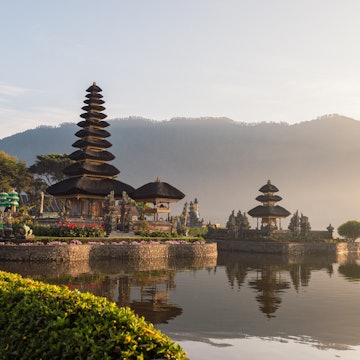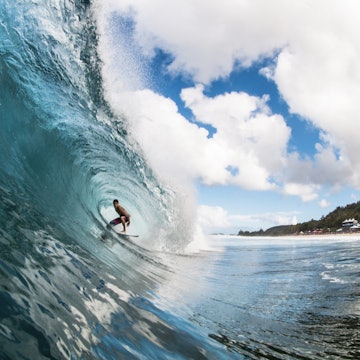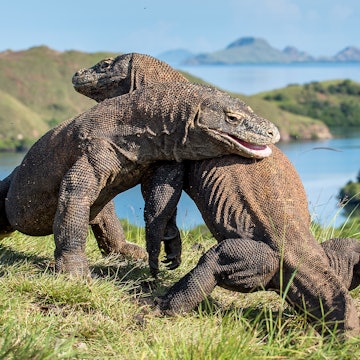
A guide to Tanjung Puting National Park, Indonesia


An orangutan and baby in Tanjung Puting National Park, Kalimantan, Indonesia. Sekar B/Shutterstock
Shared between Indonesia, Malaysia and Brunei Darussalam, the tropical island of Borneo is home to some of Asia's most spectacular wildlife. The Indonesian part of this vast island, Kalimantan, is one of the best places on the planet to see orangutans in the wild, and myriad other species thrive in the humid forests, which are a global hotspot for biodiversity.
Close to the coast in Central Kalimantan, Tanjung Puting National Park is the most popular tourist destination in the Indonesian part of Borneo, and one of the best national parks in the country. Densely forested and teeming with wildlife, it's easily reached from the town of Pangkalan Bun, served by daily flights from Jakarta and other cities around Indonesia.
In the stretches of rainforest along the Sungai Sekonyer, visitors are almost guaranteed to encounter magnificent orangutans in their natural habitat, as well as other primates such as proboscis monkeys, gibbons and long-tailed macaques. And the atmospheric journey to see them up along the winding waterways of Tanjung Puting National Park gives this adventure world-class appeal.
If your kids don't mind a bit of roughing it, this is one of the best family-friendly adventures in Borneo, but the experience will thrill nature lovers of all ages. Here's everything you need to know about visiting Tanjung Puting National Park in Indonesia.
When should I visit Tanjung Puting National Park?
June to August is high season in Kalimantan, with dry weather and good underwater visibility for those visiting the coast for diving. On land, wildlife comes out into the open, and conditions are ideal for entering the dense rainforest by boat and on foot, with fewer leeches about. This is also a great time for visiting other parts of eastern and central Indonesia, such as Java and Bali.
Orangutans become harder to spot in the rainy season from November to February, and park trails become slippery and harder to navigate. The shoulder season from April to May sees fewer visitors, but hungry orangutans are out and about in the forest and the visibility for diving remains good along the coast.

How do I get to Tanjung Puting National Park?
The main gateway to Tanjung Puting is the town of Pangkalan Bun, on the winding highway that connects the cities and towns of southern Borneo. Daily flights drop into the town's small airport from Jakarta and Surabaya, and small planes run to other airstrips around Kalimantan. There’s also an airport at Palangka Raya, about eight hours from Pangkalan Bun by bus.
Boat trips to Tanjung Puting leave from the small riverside town of Kumai, a 17km taxi ride southeast of Pangkalan Bun. If you arrange a boat tour, road transfers to Kumai will often be included in the price, but check with the operator when you book. Some agencies will pick you up from Pangkalan Bun airport and take you straight to Kumai.
If you prefer to avoid internal flights, Damri buses connect Pangkalan Bun with Pontianak in West Kalimantan, while PT Yessoe has buses from Palangka Raya to Banjarmasin and Pangkalan Bun.
How long should I spend at Tanjung Puting National Park?
Most people book two- or three-day boat tours of the park, which include transfers into and around Tanjung Puting and accommodation on board during the tour. If you’re time-squeezed, it’s possible to hire a speedboat in Kumai for a day trip to Camp Leakey, but you'll pay a premium, see less of the wildlife, and miss out on the sense of adventure that comes from sleeping overnight in the park.

Where should I stay on a visit to Tanjung Puting National Park?
Traveling up the Sungai Sekonyer in a klotok – a covered, open-sided wooden houseboat – is one of the great pleasures of a visit to Kalimantan. Boats can be small and simple, with space on deck for a couple of mattresses and mosquito nets, a table and a wildlife viewing area. They can also be lavish, with air-conditioned cabins and hot showers, and prices to match.
On all classes of boat, you can expect excellent meals prepared on board by the boat crew, plentiful opportunities to spot wildlife in the company of a skilled and experienced guide, and peaceful nights spent listening to the atmospheric sounds of the rainforest. If you come on a day trip by speedboat, consider staying in Kumai or Sekonyer to maximize your time in the park.
How much does it cost to visit Tanjung Puting National Park?
Prices for three-day boat tours from Kumai to Tanjung Puting National Park cost from US$350, including food and accommodation on board your klotok. Park fees vary depending on the activities you do on the tour, and are usually included in the tour price. Hiring a speedboat for a day trip from Kumai to Camp Leakey will cost around US$270.

What are the highlights of Tanjung Puting National Park?
Almost everyone visits on a boat tour, so the itinerary is usually set by the tour company. Compare itineraries to find one that works for you. In theory, travelers can hire a guide and klotok in Kumai and arrange a bespoke tour, but this takes some organizing and you won’t save much money. Boat tours usually include stops at the following locations.
Follow the Sungai Sekonyer
Most tour agencies visiting Tanjung Puting National Park use wooden riverboats known as klotok, which act as simple floating guesthouses. You'll depart in the morning on day one from the river port of Kumai, a short drive from Pangkalan Bun, the most popular hub for visiting the national park.
The sense of adventure grows as you cruise down the Sungai Kumai before turning into the Sungai Sekonyer and entering the territory of Tanjung Puting National Park. A mandatory park guide will be on hand to introduce you to the wildlife and explain how to interact responsibly with the fauna and flora of this richly biodiverse environment.
At this point, the Sungai Sekonyer is a muddy brown color, thanks partly to run-off from nearby palm-sugar and palm-oil plantations – a reminder of the constant threat faced by wildlife from human activity in Borneo. The banks are lined by thick mangroves and tropical foliage that reaches out over the river, adding to the atmosphere.
Make a stop at Sekonyer village
The village of Sekonyer, on the left bank of the river, is the first settlement in the park, and it's home to park rangers and people working on the palm-oil plantations. A wooden orangutan sculpture on the boat dock greets visitors, but most don't linger. A simple homestay by the boat dock offers basic but expensive riverside rooms if you’re coming on a bespoke tour.

See your first orangutans at Tanjung Harapan
Upriver from Sekonyer Village, Tanjung Harapan is the first of three orangutan feeding stations that you'll visit on your trip. The platforms where food is laid out to tempt orangutans down from the trees stand a 700m walk through the forest from the boat dock. You'll want to be here around 3pm, when orangutans gather for a feed.
The apes who come to the feeding stations in the park are mostly orangutans who have been rehabilitated and released in Tanjung Puting after being freed from captivity. The feeding station at Tanjung Harapan is a wooden platform loaded with fruit and buckets of soy milk, separated from visitors by a rope to put the orangutans at ease.
It's not quite the same as encountering truly wild orangutans in the virgin rainforest, but the feeding stations support orangutans on their journey back to their natural habitat, and sightings are much more common than on expeditions to more impenetrable parts of the Bornean jungle.
Arrive at feeding time, and you’ll see the surrounding trees shaking as the apes approach, although some orangutans crash through the foliage at ground level and just wander nonchalantly through the crowds to the platform. You may see mothers with adorably cute infants clinging to them, as well as the local alpha male occupying the center of the platform.
Some apes take an interest in the people observing them; others turn their backs as they suck on mangoes and bananas. Either way, the photo opportunities are excellent; bring a long lens for close-up shots from behind the ropes, as the platform is some distance away.
Boats often dock overnight at Tanjung Harapan, tying up before sunset. A sense of calm descends over the jungle as a background chorus of jungle bugs rises in the darkness. Listen out for the occasional calls of nocturnal wildlife.

Go night trekking
On either your first or second night in the national park, you’ll get a chance to go night trekking with a park ranger. Lasting a couple of hours, these treks normally take place at Pondok Ambung, Pondok Tanggui or Tanjung Harapan. Wearing a head-torch (flashlight), you'll have a truly illuminating experience of the rainforest, with a good chance of spotting nocturnal wildlife.
You’re almost certain to encounter Borneo pit vipers hanging from the branches of trees, and pythons are commonly spotted. On the forest floor, tarantulas emerge from their burrows and giant forest ants crawl across the leaf litter. If you’re truly fortunate, you may spot tarsiers – tiny and shy primates with enormous eyes. They emerge at night to feed on insects and spiders.
Whether you walk by day or by night, don’t wear flip-flops (thong sandals); there are fire ants and leeches in the leaf litter and it’s easy to get scratched by hidden roots or sharp vegetation along the paths.

Drop into Pasalat
As you head upriver, more and more wildlife becomes visible. Proboscis monkeys leap through the trees along the riverbanks and you may see wild orangutans close to the river, too, especially in the morning. Hornbills and kingfishers fly overhead and crocodiles can sometimes be glimpsed floating like logs in the river or resting on the banks.
Boats don’t always stop at Pasalat’s reforestation camp, but it makes an interesting detour. Around 50 hectares have been reforested with ironwood saplings since 2000, and a medicinal plant garden is also maintained here. Ambitious hikers can trek between Pasalat and the Pondok Tanggui orangutan feeding station in around five hours.
See more orangutans at Pondok Tanggui
Pondok Tanggui is the second orangutan feeding station along the river, and perhaps the best, because visitors can get really close to the apes, with the feeding platform just 10m away from the roped-off viewing area. Feeding starts at 9am, with the platform reached via a 1km walk through the forest; bring drinking water as it gets hot here.
The orangutans approach from all directions, dropping down from the trees or ambling up the same walking trail that tourists use. The apes often linger after the fruit and milk have gone, as they do at all the feeding stations, so there’s plenty of time to observe their interactions with each other.
Feedings at Pondok Tanggui are often enlivened by marauding packs of long-tailed macaque monkeys, who like to raid the platform at the start of the feeding sessions, making off with as much fruit as possible, to the great annoyance of the orangutans.

Seek rare species at Pondok Ambung
Home to a research station run by the Orangutan Foundation International, Pondok Ambung uses remote infrared cameras to monitor the park’s nocturnal wildlife. This is the prime spot for night treks to search for spiders, snakes, insects and strange glowing mushrooms. Elusive tarsiers, sun bears and clouded leopards are sometimes spotted here, too, along with plenty of primates.
As you continue along the river from here, the Sungai Sekonyer narrows significantly and the water color changes to inky black. Here, in the deep forest, you'll see primates all around, from chattering macaques foraging along the riverbanks to proboscis monkeys jumping from tree to tree. You might also see wild orangutans perched in the highest branches of the trees.

Walk in the footsteps of great naturalists at Camp Leakey
The last destination for Tanjung Puting tours, Camp Leakey was the original research station in the national park and it was named in honor of the late palaeoanthropologist Louis Leakey. His assistant Biruté Galdikas – a colleague and contemporary of Dian Fossey and Jane Goodall – founded the camp in 1971
The main attraction here is the feeding platform located 1km from the boat dock. Feeding time is at 2pm and this station often attracts white-bearded gibbons, who sit in the trees above the platform ready to swing down and grab some fruit before the orangutans arrive. You'll also spot plenty of macaques squatting on the boat dock.
After visiting Camp Leakey, the klotoks turn around – not an easy maneuver when the river is narrow and jammed with boats – before heading downriver to anchor for the final night of the tour. Depending on the operator, you may get the chance to canoe along the river for an hour the following morning, before returning to disembark at Kumai.
Is Tanjung Puting accessible?
Some agencies say their tours are open to people with mobility issues, as there are boardwalks or level paths to the feeding stations, but you’ll still have to make your way onto and off the boats. With support from the crew or companions, visiting Tanjung Puting with a wheelchair is possible, but don’t expect a smooth, seamless process.
This article was adapted from Lonely Planet’s Indonesia guidebook, published in July 2024.












